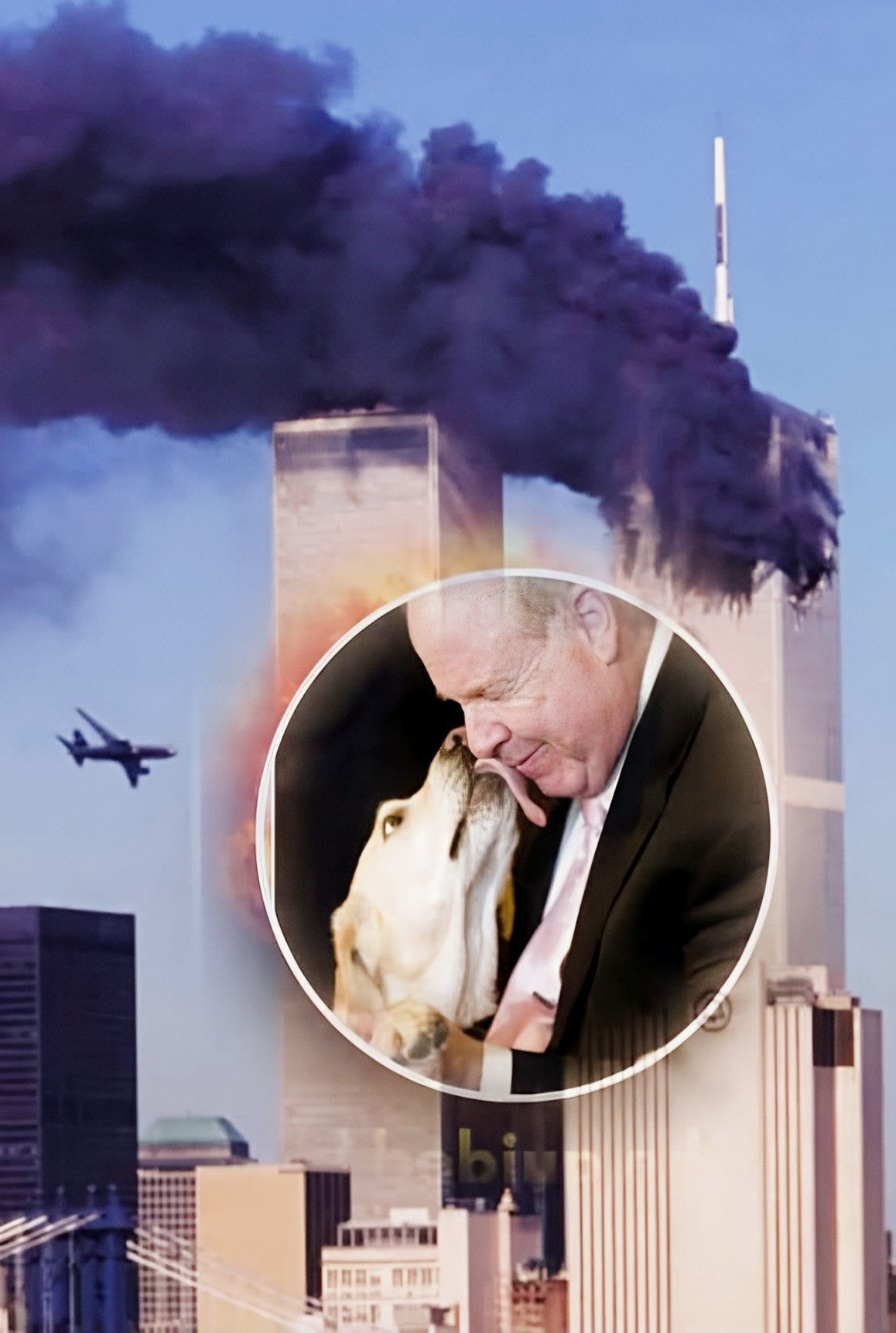On the morning of September 11, 2001, the sky above New York City was crystal clear—an ordinary Tuesday that would soon become one of the most unforgettable days in modern history. On the 78th floor of the North Tower of the World Trade Center, Michael Hingson had just settled into another routine day at work.
Michael, blind since birth, couldn’t see the blue sky outside or the looming shadow of the hijacked plane approaching. But at 8:46 a.m., when American Airlines Flight 11 struck the building just 18 floors above him, he felt everything. The massive jolt, the shuddering steel, the distant sound of an explosion—his world, already dark, shook with terrifying force.
Next to him was his yellow Labrador guide dog, Roselle. She had been dozing under his desk before the impact, but when the floor trembled and sirens screamed to life, Roselle calmly got to her feet. There was no panic in her body, no hesitation in her movement. For Michael, her reaction was the signal he needed to act fast.
“She remained calm, showing no signs of fear—and in that moment, I knew we still had a chance,” Michael later recalled.
What followed was a descent that would test every ounce of courage, determination, and trust between a man and his dog. Together, they began the long journey down 1,463 steps to safety. Smoke filled the stairwell. The smell of jet fuel hung thick in the air. Injured people leaned against walls or crawled downward. Some cried. Some prayed. But Roselle led Michael with steady, confident movements, ignoring the chaos around them.
At one point during the descent, a colleague, overwhelmed by fear and hopelessness, cried out, “We’re not going to make it!”
Michael turned toward the voice and replied softly, “If Roselle and I can make it, so can you.”
It was more than a statement—it was a lifeline, a spark of hope in a place where despair had begun to take hold.
Step by step, floor by floor, they moved past people too frightened to continue. Roselle guided Michael around debris, over fallen bodies, and through clouds of smoke. Firefighters passed them on their way up, rushing toward the flames above. Many of those brave souls would never return.
“I remember thinking how courageous they were,” Michael said. “They knew what they were going into.”
Finally, after what felt like an eternity, they reached the lobby. It was just minutes before the tower collapsed. Outside, the sky had turned dark with ash and pulverized concrete. People were running, screaming, covered in dust. For a moment, no one could see anything.
But for Michael, that world of darkness was familiar.
“I had lived my whole life without sight,” he explained. “But in that moment, everyone was blind. And for once, I wasn’t the one who was afraid.”
Still led by Roselle, they moved cautiously through the debris outside. At one point, Roselle suddenly stopped. Michael reached out with his cane and discovered a drop—a staircase leading down into a subway entrance. That staircase brought them out of the chaos and into clearer air, away from the suffocating dust and noise.
That day, Roselle did more than lead Michael out of a collapsing skyscraper. She stayed calm under the most extreme pressure, navigated through a maze of fire and panic, and reminded everyone around her of the power of trust, loyalty, and courage.
“That dog saved my life,” Michael has said many times. “And she did it without ever knowing she was doing anything remarkable.”
But Roselle was remarkable. In the aftermath of 9/11, she became a symbol of heroism. Michael and Roselle went on to share their story across the world, not as a tale of tragedy, but as an example of resilience, trust, and the quiet, everyday power of a working dog.
Roselle passed away in 2011, but her legacy endures. She was posthumously awarded the Hero Dog Award and remains one of the most celebrated guide dogs in American history. Her story continues to be told in classrooms, documentaries, and books—including Michael Hingson’s memoir Thunder Dog, which chronicles their escape and the extraordinary bond they shared.
Beyond the fame and recognition, Roselle’s story highlights something far more important: the underestimated value of dogs in our lives.
Guide dogs are not just assistants—they are lifelines. They provide independence to those who are blind or visually impaired. They navigate their handlers through streets, buildings, airports, and crowds. They are trained to remain calm in emergencies, to problem-solve, and to make decisions that can mean the difference between life and death.
Yet, too often, their importance is overlooked.
As Michael once said in an interview, “People think blindness is a tragedy. But for me, what would be a tragedy is not having a dog like Roselle. She gave me more than sight—she gave me the ability to live.”
In a world where tragedies like 9/11 remind us how quickly life can change, Roselle’s story offers a message of hope. It’s about the quiet strength that lives in the unlikeliest of heroes. It’s about loyalty that doesn’t flinch in the face of terror. And it’s about the life-saving bond between a man and a dog who walked out of darkness together.
Let us not forget that sometimes, the greatest heroes walk on four legs.

